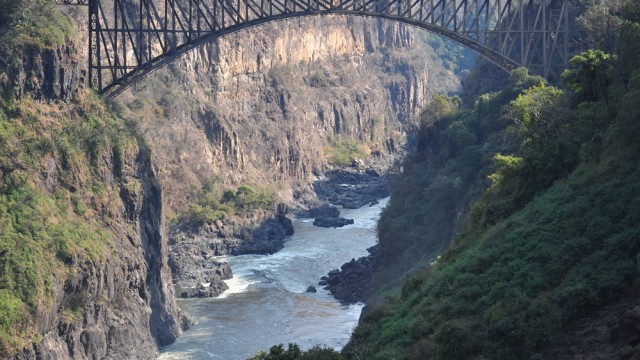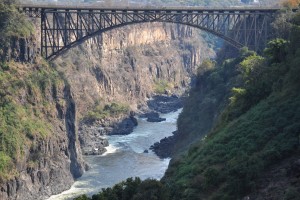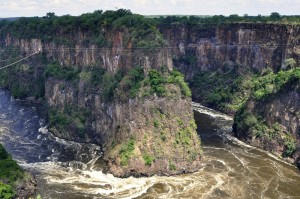I’ve rafted the Zambezi River twice: once at high water and once at low water, and on neither expedition did I fall out of the raft. But that’s not everyone’s experience. My sister’s raft flipped during her run, and she nearly drowned in a hole. To this day she won’t get back in a boat. Rafting the Zambezi can be that terrifying.
But as someone who has run the river twice without incident, I can say it is the adrenaline rush of a lifetime, and one you shouldn’t let my sister’s near-death experience scare you off of. (Just FYI, she’s also terrified of fish and snorkeling, so maybe it’s a water thing.) Yes, this river is intense: if it was in the U.S. it would likely not be commercially run, as no insurance company would want to cover the risk. But this is Africa, where extreme experiences are a rite of passage.
The day trip begins in the Batoka Gorge, just below Victoria Falls. You’ll be picked up from your hotel at 7am and driven as close to the put-in as possible – to reach the river, you’ll still have to descend the gorge. But first, you’ll meet your guide and go over basic safety skills. Whatever you do, pay attention during the lecture. For instance, if you fall out of the boat, you’ll need to remember to keep your feet up and pointed down river to avoid getting trapped in the rocks that helped jolt you out of the boat in the first place.
“Don’t panic if you see a crocodile when you’re in the water,” the guide tells our group. “It will just be a baby. The big ones can’t survive the tumble over the falls.”
I notice his words have an effect on others in our group, but I’m less worried about the crocs than the rapids. This is my second trip down the Zambezi, but my first low water experience. During high water, the rapids themselves are bigger, but they are also quite a lot safer – you just crest over the waves rather then getting stuck between rocks if you pop out. It’s during low water when this river really shows its teeth. I shiver. It’s August, which is the dead of winter here, but the air isn’t making me cold. It’s the thought of getting my foot jammed in a rock when we flip that’s making me shake.
After the safety talk, it’s time to hike down to the river. While you can run the Zambezi from both Zimbabwe and Zambia, the Zimbabwean side provides a more dramatic entry and exit — you have to descend to the bottom of the canyon to start, and also to get out at the end. Hiking down, the scenery is spectacular: sheer walls of black basalt soar upwards, while the roar of the river can be heard from below.
Africa’s fourth-longest river begins in Zambia’s remote northwest corner, close to the Congolese border, and then weaves a southeastern course through six countries before eventually ending its 1,670-mile (2687 km) journey in the Indian Ocean off the coast of Mozambique. Along the way, it tumbles over one of the world’s most magnificent waterfalls, Victoria Falls, and forms the border between Zimbabwe and Zambia. After crashing over the falls, it enters the gorge it carved over the millennia, and the whitewater adventure begins.
Upon reaching the bottom of the gorge, you’ll pull on your wetsuit and tighten up the life jacket. You’ll buckle into your helmet, grab a paddle, and join your team in the raft. Before starting out, your guide will quiz you on the safety lecture and make sure you understand the basic commands, as well as how to flip the boat back over in an emergency.
If you study the map of the rapids on the adventure shop walls before signing up for the trip, you’ll notice that almost half of the 20 or so named rapids encountered on a full-day trip are classified as a Class V. In whitewater talk, this is only one level below insane.
Before each major rapid, the guide will stop the boat and tell your group how each rapid will be navigated, how to paddle it, and in some cases your likelihood of flipping. In some cases you’ll all get out and scout it on foot. Don’t pay attention to the flipping part, just remember to brace yourself and never stop paddling unless the guide tells you to — if everyone freaks out and forgets to paddle going through a tough rapid there won’t be enough momentum to pull the boat forward, or allow the guide to properly steer, and this is when you end up with the front half of the raft straight up in the air and the back dipping into the angry river.
And this is exactly what happens on our first major rapid, known as the “Morning Glory.” The guide is screaming at us to paddle, but our team of six are petrified by the wall of water coming at us and everyone suddenly just freezes, which plunges us into a hole and has us “surfing.” As the guide tells us after we escape, this means going forward and backwards, but not getting out. Seconds later, the front of the boat goes straight up in the air and people begin to tumble out. The guide screams, “paddle hard,” and those of us at the back begin to. The momentum of our arms driven by our adrenaline propels us forward and out before we flip and then we’re cruising down river again, throwing out the safety rope to collect our victims (who have all managed to keep their feet ahead and safely negotiated the rocks).
We’ve only just recovered from “Morning Glory,” when the guide stops to tell us about the next rapid, “Stairway to Heaven,” which is the day’s first Class V. And if I remember correctly from the high water run, it’s a serious stomach-dropper. You have to paddle hard and stay straight. If you go too far to the left, you’ll hit a massive crushing wave guaranteed to flip the boat, and if you go too far to the right you’ll hit a massive waterfall. We watch the boat ahead of us get swept too far to the left when the terrified participants stop paddling and flip. But we’ve learned our lesson, and no one stops paddling when the guide tells us to “dig in.” We manage to drop down the two-story-high descent with ease.
At the end of the day, the most intense part of my second trip down the Zambezi has nothing to do with water. The hike out of the gorge from the Zimbabwe side is a strenuous 25-minute trek that is straight uphill and isn’t easy under ideal conditions. After exiting the raft and taking my first wobbly steps on dry land, the strap on my right sandal gives out, and no one has anything to patch it up with. I end up abandoning the shoe entirely halfway up, and hiking barefoot – luckily cold beers are waiting at the top. So while I may have been lucky enough to survive two Zambezi trips without a PTSD-worthy experience, I did manage to give myself some seriously painful blisters. In a way, I wish I’d fallen out of the boat — it would have made for a more dramatic ending.




